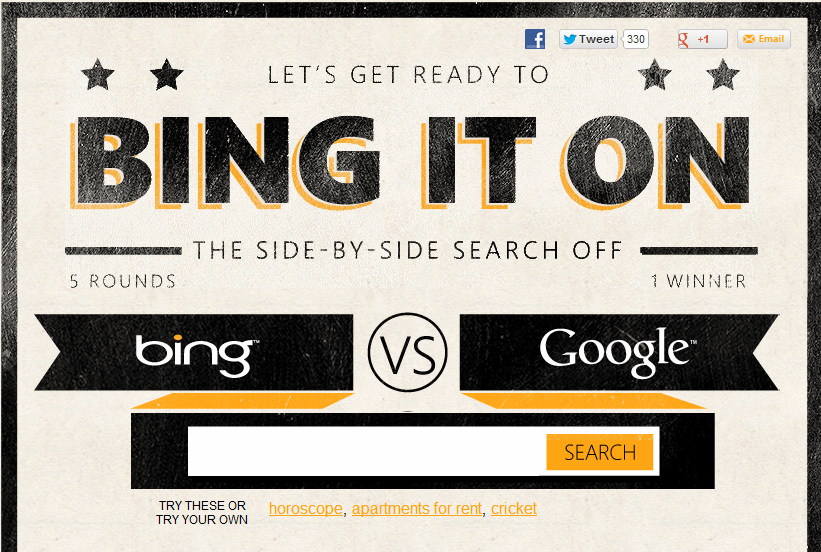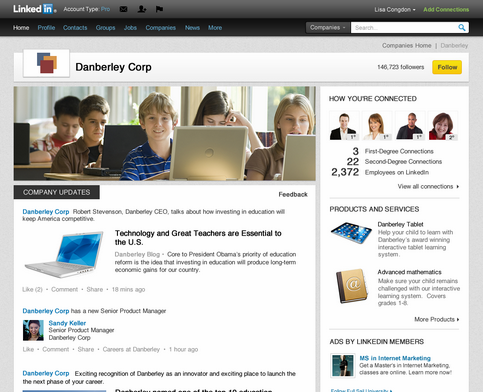Even with a massive disadvantage in the search market, Bing is convinced it has a search engine as good as Google’s. The company made this clear last week in an interesting announcement aimed at showing off just how useful its results can be. Bing launched “Bing it On,” a tool designed to directly compare SERPs from the two search engines.
BingItOn.com asks users to test five separate search queries. After each search, users select one of two SERPs based on the results that most accurately satisfy their requests. After the five searches, the site tells users which company’s results they selected. The aim of the feature is to show users that Bing results can be as effective as Google’s for providing the information they want. However, this could backfire if users continuously select Google over Bing, as was the case with Brafton’s test of the tool.
Attempting to attract more users from Google has been a long battle for Bing that hasn’t yielded much progress regardless of the innovations, new features and tools for marketers the company has developed. In a blog post discussing Bing It On, Harry Shum, corporate vice president of research and development for Bing, wrote that the company has worked tirelessly to make Bing an attractive option for users. Still, Google remains the clear leader in search with the most recent numbers suggesting the company fields more than two-thirds of all queries.
Part of Google’s dominance in search has been its insights provided to marketers related to SEO. As a result, organizations of all sizes in any number of industries have actively attempted to make their sites more user-friendly. The creation of high-quality website content that wins visibility and engages traffic, while also telling Google a site is trying to provide its visitors with a strong user experience is an important element of these strategies. According to a report released by IDG Enterprise, B2B companies have been especially aggressive in creating the type of website content that attracts relevant traffic that results in more leads and conversions.
Throughout the week, Brafton highlighted different elements of the study, which found a diverse content marketing strategy is most likely to help companies achieve their goals on the web. The chief goals named by marketers in the survey are lead generation (68 percent), thought leadership (50 percent) and brand awareness (39 percent). With any marketing campaign, driving sales is the main goal, but the web has changed the way consumers and B2B buyers decide on the products and services they plan to buy. Developing content that educates shoppers and guides prospects through a conversion funnel without overt selling is more likely to result in a sale than other kinds of techniques on the web.
According to IDG, 84 percent of companies included in the survey said they will increase their investment in content marketing moving forward.
According to IDG, 84 percent of companies included in the survey said they will increase their investment in content marketing moving forward. The types of content these organizations will create are widespread. Case studies are currently the most popular content format, with 62 percent of respondents saying they use them. Moreover, white papers that help position organizations as thought leaders are produced by 61 percent. Other popular content types include blogs (50 percent) and social media marketing (50 percent).
With social marketing, companies expect to improve brand visibility on the web. Brafton reported that as B2B marketers become more active in the channel, they’re finding the it increasingly effective. Forty percent of all respondents said social media has directly improved their marketing on the web. LinkedIn and Twitter were the most popular platforms among respondents, with 85 percent and 70 percent using them respectively. Managing social strategies and creating different kinds of content can be difficult for any organization. IDG found that 30 percent of companies included in the poll have opted to outsource part of their strategies to ensure they develop enough content and optimize it for their target audiences. Brafton reported that one of the greatest benefits of outsourced content marketing is alleviating the strain of handling these new efforts internally and freeing up employees to focus on other tasks. Writing effective site content and managing a series of social marketing accounts requires a level of expertise that many don’t have or simply can’t afford to staff internally.
Additionally, these social networks become increasingly complex, and last week the sites added new features for both marketers can consumers. LinkedIn rolled out new Company Pages, which place a strong focus on shared social content. Brafton reported that businesses active on the site must ensure they populate their Pages with site links and other content, as a majority of the real estate on the redesigned Pages is dedicated to brand activity. Posting links, asking questions and sharing other kinds of social content must become a priority for marketers to make LinkedIn a value-adding element of a social strategy.
Marketers often struggle in deciding the types of content to share on social networks. Diffbot provided a detailed picture of the content Twitter users link to on the microblogging site. Mashable relayed the study, which found that over a studied period, images accounted for 36 percent of shared content. News articles were the subject of 16 percent of shares. Diffbot analyzed 750,000 Tweets sent over 24 hours to amass its results.
Brafton reported that visual content has always been a strong traffic driver for marketers using social networks. Integrating infographics, product images, company photos and other visuals provides fans and followers an engaging experience that can help drive site traffic and pique interest in a brand.
With so many different kinds of website content helping marketers drive leads and sales, it’s important for companies to remember that quality content will always perform better than abundant content. This is especially true as web marketers everywhere await the release of the next major search algorithm from Google. The company has steadily rolled out minor updates to its Panda algorithm in recent months. However, Matt Cutts has hinted that big SEO changes are on the horizon as the company attempts to promote the best web content through search – this time through Google Penguin.




